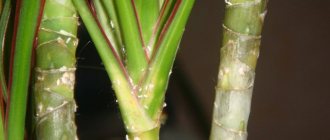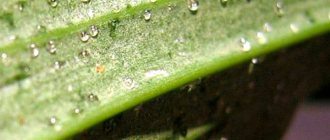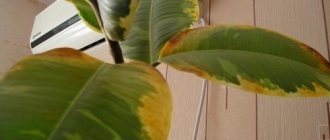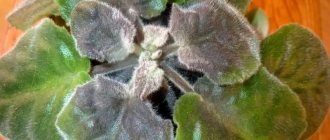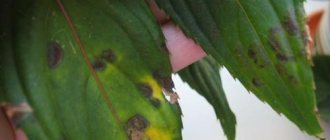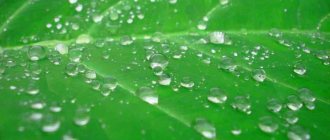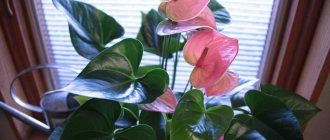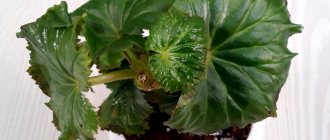A bright exotic flower came to us from South America. From the ancient Greek language the name Anthurium is translated as “tail” and “flower”. The plant belongs to the Araceae family. Flower colors can be very diverse, and flowering lasts all year round and depends on the lighting. The flowers have such an unusual shape and glossy surface that they have become indispensable for florists when creating compositions.
Anthurium
A cut flower can stand in water for up to a month without losing its qualities. Since it comes from the tropics, there are certain care requirements that are very important for this species - temperature, lighting and humidity. Failure to follow the rules affects the beauty of the leaf plate. In order for the anthurium to delight with its flowering, as in the photo, it is important to determine in time the cause of the change in the appearance of the leaves in order to determine how to properly treat and prevent more serious diseases in time.
How to revive a plant in advanced cases
It happens that the problem was identified untimely due to the departure or busyness of the owner.
You can save an anthurium even if it has no leaves at all. When performing work, remember that the plant is poisonous, its juice contains toxic compounds and can be absorbed into human skin and leave burns on it. The plant itself belongs to the group of epiphytes; its reproduction is ensured by aerial roots. If the anthurium has dropped all its leaves, it should be removed from the pot. This is necessary to inspect the root system for rot, infections and pests.
@ Martina stock.adobe.com The appearance of yellow spots along the edge of the leaf may indicate overwatering of the root system or insufficient air humidity
It is mandatory to treat the plant using chemicals. If there are dormant buds (green tubercles) on the surface of the trunk, there is a chance of salvation.
Do not forget about the following point: the root system of anthurium is fragile, so the grower must be careful when working with it. Roots that are white or yellow and firm to the touch are considered alive.
Black and soft - rotten, they do not take part in the process of providing the aboveground part with nutrients. In addition, they are considered a source of infection; their decomposition process can spread to the stem and leaves.
Plant resuscitation is ensured according to the following algorithm:
- The first thing to do is to stimulate the development of aerial roots. They actively grow and develop in a warm and humid environment. If the stem has no roots at all, it should be wrapped in sphagnum and placed in a humid environment, such as an improvised greenhouse. Full roots will sprout in 2-3 weeks.
- The resulting sprout can be rooted in a small pot, but for the above-ground part it is necessary to arrange a greenhouse. The appearance of new leaves indicates that the plant has taken root.
@ Molly stock.adobe.com Anthurium Pink Flamingo
Before re-rooting, you need to make sure that the roots of the plant are really damaged. To do this, a simple experiment is carried out: the roots are soaked in warm water and cleaned of the remaining substrate. Living elements after this process will be noticeable; they have a white or slightly creamy color and a dense structure.
Preventive measures
Why do hydrangea leaves dry around the edges - what to do and how to revive the flowers
Prevention of blackening of anthurium consists of proper care and provision of favorable conditions for its life.
Useful tips for proper care
In order for anthurium bushes to bloom all year round, and for the flowers to be beautiful and bright, it is necessary to care for it correctly and in a timely manner. Basic recommendations:
- Choosing a room. In the room, the anthurium should be placed on a southeast or west window so that the flower can receive enough sunlight. This will prevent the plant from getting burned due to direct light at midday. In winter, the flower should be placed away from equipment for heating the room. If it is impossible to move the plant to another part of the house, place a tray of water next to the pot. As it evaporates, the air humidity will increase.
- Selecting soil and container for planting. Rhizomes can suffocate due to lack of oxygen. To avoid this, you need to use a soil mixture that allows air to pass through. River sand and oak bark, as well as crushed peat, are added to it. It is better to take a plastic pot.
- Humidity. To provide comfortable conditions for anthurium, you need to create a tropical climate for it. To do this, the leaves of the flower are sprayed with water daily and checked to see if it is dripping onto the surface of the inflorescences. In addition, experts recommend regularly placing the flower pot in a pan of water for a few minutes.
- Watering. In hot summers, it is recommended to add nutrients to the soil along with water. This should be done no more than 2-3 times a week. In winter, the frequency of watering is reduced to once a week. It is better to irrigate the plant using a watering can or sprayer. After watering, it is recommended to wait until some of the water is absorbed and remove the rest.
Placing a flower indoors
To determine the cause of blackening of anthurium leaves, you need to constantly monitor the plant. It is better to eliminate identified problems at an early stage of the appearance of spots than to pull out and throw away infected bushes.
Why do anthurium leaves turn yellow after transplantation?
Often gardeners are faced with the problem of yellowing leaves of anthurium after transplanting it. It should be noted that this procedure is a kind of stress for the plant, the consequences of which can negatively affect the condition of the flower.
The reasons that the leaves darken and turn yellow after transplantation may be:
Untimely flower transplantation. A young plant up to 4 years old needs to be replanted annually into a new container with a new substrate. It is recommended to plant adult perennials in a new pot every 2–3 years. At the same time, it is recommended to carry out activities for transplanting exotic plants in early spring - from February to May.
Pot size. It is necessary to choose a container that is 2–3 cm larger in diameter than the previous one, with large drainage holes required to remove excess moisture.
The soil. For an epiphyte, the optimal soil composition is a mixture of humus, leaf soil, peat and river sand, mixed in proportions 2: 2: 1: 0.5
It is very important that the soil is as breathable as possible, light and loose. Hard, heavy, airtight soil will cause foliage to yellow and dry out.
Feeding
Experts advise carrying out the first feeding after transplanting a perennial no earlier than one month. During this time, the plant will have time to adapt to new conditions and begin to actively develop.
It is worth noting that yellowing of the leaf blades after replanting can be caused by the use of low-quality water for irrigation. Water with impurities of heavy metals or chlorine is harmful to the flower.
Useful care tips
Anthurium is considered by many to be a capricious flower to care for. However, by following the basic rules of its agricultural technology, you can avoid many problems and grow a healthy, aesthetically attractive decorative flower:
- It is recommended to place the pot with exotic on the windowsill on the western or eastern side of the apartment, where diffused bright lighting predominates. Despite the fact that the perennial is a shade-tolerant crop, in full shade it will stop blooming and stop growing;
- to ensure the required high level of humidity in the room, flower growers advise installing additional sources of moisture near the flower, for example, special humidifiers, decorative fountains, aquariums with fish, etc.;
- when watering crops, you should follow this rule - the lower the temperature in the room, the less often the exotic should be moistened;
- since the plant is an epiphyte, the soil for it should be as light, loose, nutritious, moisture- and breathable as possible;
- Regularly, in the spring, after winter dormancy, it is necessary to carry out the procedure for rejuvenating the flower by removing damaged, dry, weak branches and shriveled leaves.
Even experienced gardeners sometimes have to deal with the problem of yellowing and darkening of anthurium foliage. In some cases, this problem may arise due to natural changes in the condition of the flower, but most often it is associated with violations of the basic rules of caring for it. However, almost all possible reasons can be corrected and as a result you will get a beautiful exotic perennial that will delight you with its unusual appearance for many years.
Why do the leaves of the “male happiness” flower become covered with brown spots?
Most often, brown spots appear on anthurium leaves due to non-compliance with care rules. If you study all the individual characteristics and “whims” of the plant, you can easily achieve maximum decorativeness of the look.
Anthurium houseplant
There are several reasons why anthurium leaves may turn brown:
- Improperly organized watering of the plant.
- Untimely application of fertilizers to the soil.
- Very dry air in the room where “male happiness” grows.
- Failure to comply with the length of daylight hours.
- Sharp cold snap.
Failure to follow the rules of care can lead to rotting of the roots and the rapid spread of fungus. The plant may also become covered with spots due to attack by pests.
Change leaf color
Overflow
For this species, it is extremely important to comply with watering standards. Excess moisture, as well as deficiency, will certainly lead to anthurium diseases
Frequent and irregular watering will lead to rotting of the roots.
Brown spots may appear on the leaves if liquid gets on the plate itself. If you do not respond to the problem in a timely manner, this can lead to the death of the entire green part of the plant.
Popular articles Black truffle: description of the mushroom, value, market value
On a note! High humidity is a favorable environment for the development of mold and fungal infections.
Watering with cold water
The use of cold running water is detrimental to anthurium. The chlorine it contains instantly damages the roots.
It is recommended to water the flower with warm water, standing for 2 days.
Unsuitable soil
Thanks to high-quality soil, the plant is nourished. Anthurium loves nutritious soil. It is very easy to prepare it yourself. To do this, you need to mix the ingredients in the following proportions (2:1:1:0.5):
- humus;
- leaf soil;
- peat substrate;
- river sand.
Important! It is imperative to lay a thick layer of drainage material at the bottom of the pot.
Low room temperature
A low temperature can cause harm only if the anthurium is left in such a room for a long time. Short-term changes do not pose any danger.
Failure to comply with the temperature regime leads to damage and rotting of the roots. The leaves turn yellow and dry out completely. The flower stops developing and dies. For salvation, it is necessary to create the right conditions and carry out the necessary treatment.
Attention! Yellowing of the leaves can occur for natural reasons - due to the age of the flower. If the lower ones turn yellow and fall off, then you should not worry.
After a short period of time, new ones will grow.
Root damage
During replanting, unintentional damage to the root system may occur. Because of this, black spots appear on the flower.
The event must be carried out as carefully as possible - using the transshipment method
Even if the root shoots were accidentally broken or damaged, they must be treated with manganese and sprinkled with charcoal before being lowered into the ground.
Sunburn
A change in foliage color may indicate that you have chosen the wrong location for the anthurium. Placing the plant on a south-facing windowsill can lead to sunburn. Their appearance is characterized by yellowing and curling of the foliage.
To save the flower, it must be moved to a shaded area of the house.
Septoria infection
This disease develops as a result of damage by a fungus. If treatment measures are not taken, the spots will grow quite quickly. With a prolonged disease, the leaves turn completely black.
Septoria lesion
This infection must be treated urgently. To do this, treatment is carried out with Fitosporin or 1% Bordeaux mixture.
Attention! All damaged areas must be completely destroyed
Aphid attack
Parasitic aphids live on leaves and suck the juice from them. Therefore, the leaf plates curl and become sticky. Without proper treatment, the flower quickly dies.
To treat the anthurium, it is necessary to wash it with soapy water and then pour it with manganese or Fitosporin.
Aphid invasion
Scale insect attack
What to do if brown spots appear on the leaves of anthurium due to an attack by scale insects? The first signs of an attack by these particular insects are pronounced white or yellow tubercles.
Most often they appear on the leaves, and only then cover all the green parts of the flower. The scale insect feeds on the sap of the plant and because of this, the leaves begin to dry out and tear. For treatment, it is recommended to use any fungicidal preparations.
External signs of scale insect damage
How to treat fungal and bacterial diseases of anthurium leaves
Treatment of anthurium directly depends on the cause of the disease. First of all, you should check whether the flower is suffering from drafts or sudden temperature changes, since this is the most common mistake in care. This could be an air conditioner, a fan, a constantly opening balcony door or a slightly open window for ventilation in winter. If the cause is found, then there will be no re-yellowing. But the plant still needs to be revived.
If the leaves have turned yellow in large quantities, then you need to replant to inspect the roots and change the soil; most likely, we are talking about an infectious lesion. Treatment is carried out according to the following algorithm:
- Remove all affected leaves with sharp pruning shears, and treat healthy ones with Epin, a stimulating drug.
- Carefully remove the plant from the pot. To do this with minimal trauma to the roots, it is better to water the flower a couple of days before transplanting.
Transfer - Remove all soil from the roots and wash them with warm, soft water.
Cleaning the root system - Inspect the roots for rot, dryness or lesions. Cut off all unhealthy areas with a sharp, sterile knife.
Root treatment - Treat the roots with fungicides to prevent or treat fungal and bacterial infections.
- If after pruning there are no roots left, but there are still growth points, then you need to wrap them in damp moss and place them in a transparent glass. Ventilate for 15-20 minutes every day. Keep in a greenhouse with good humidity, under a phytolamp. When new roots appear, proceed to step 7. If after pruning there are still living roots, then skip step 6.
Sprouting new roots - Prepare a new pot, which needs to be selected according to the size of the roots. They should not be cramped, but too much space can destroy the plant, since all the energy will go into the growth of roots.
- Fill the pot 30% with drainage. Next is a layer of soil. Soil should be taken for orchids; it is best suited for weakened anthurium.
- Plant a plant and fill the voids with soil.
- Care during the recovery period must be very careful, observing all the necessary rules for keeping this species.
What to do if only the tips of the leaves turn black?
The cause of blackening of the tips is fungal diseases. In this case, it is necessary to carry out antifungal therapy and eliminate all causes associated with caring for the plant. A humid and warm climate promotes the development of fungal diseases; it is necessary to regularly ventilate the premises, water the flower moderately and give preference to ceramic pots.
Separate publications by our experts will help you grow blooming and healthy anthurium at home, from which you will learn:
- Why can a plant grow poorly and what can be done to achieve flowering?
- Why might leaves dry out?
- What to do if the flowers turn green or become small and pale?
Leaves turn black - reason: pests
Pests that like to settle on anthurium include representatives of aphids, root nematodes, spider mites, scale insects or thrips. All these parasites feed on the sap from the plant, located on the lower cavity of the leaf blades, as well as in the connectors of the leaf and stem.
A rather dangerous enemy is the spider mite.
To neutralize it from the plant you have to fight. The first signs of a mite are a web formed in the branching of the leaf blade and stem. The web gradually grows, occupying the entire area, and engulfs the plant, causing it to dry out and die. Not a single flower is safe from the invasion of these parasites. They can colonize by being transported by the wind, or if an infected plant was purchased.


